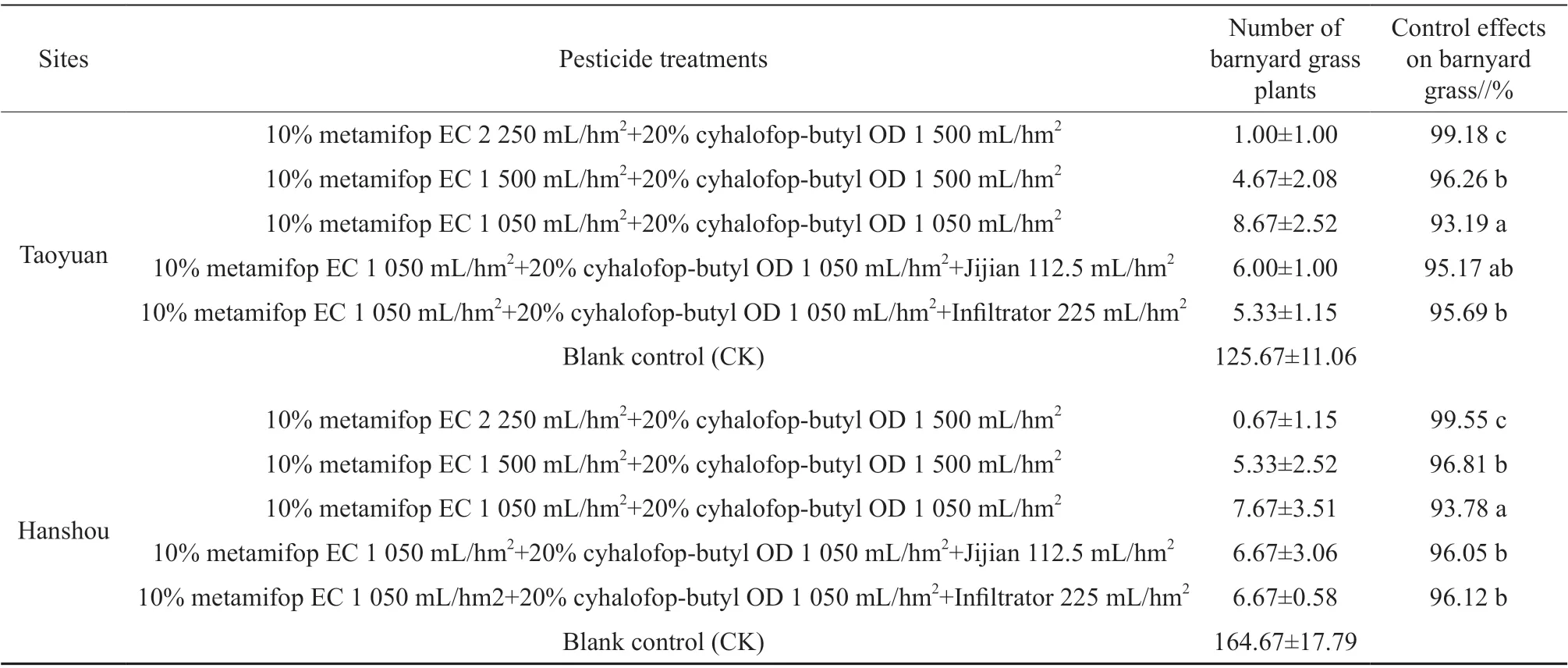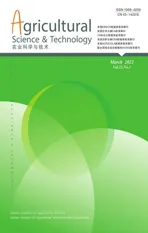Control Effects of Mixture of Metamifop and Cyhalofopbutyl on Annual Weeds Barnyard Grass in Directseeding Paddy Field
2022-06-18ZHUXiongmeiDENGHuifangTANXianshengGUOKaifaJINChenzhongHANQingZHOUYou
ZHU Xiong-mei, DENG Hui-fang, TAN Xian-sheng, GUO Kai-fa, JIN Chen-zhong, HAN Qing,ZHOU You
Collaborative Innovation Center for Farmland Weeds Control Technology and Application, Hunan University of Humanities, Science and Technology, Loudi 417000, PRC
Abstract In order to explore the control effects of 10% metamifop EC and 20%cyhalofop-butyl OD on barnyard grass (Echinochloa crusgalli (L.) Beauv.) as well as their safety to rice in rice direct-seeding paddy field, field efficacy experiments were carried out in Taoyuan County and Hanshou County of Hunan Province. The results showed that the control effect of different pesticide treatments on barnyard grass was good, and the control effect reached more than 93%. Of which, 10% metamifop EC 2 250 mL/hm2+20% cyhalofop-butyl OD 1 500 mL/hm2 had the best control effect,exceeding 99% and each treatment had no significantly ponisonous to rice. However,considering cost-saving and effect-increasing, it was recommended to use 10%metamifop EC 1 050 mL/hm2 mixed with 20% cyhalofop-butyl OD 1 050 mL/hm2 for the control of barnyard grass, which not only had the effect of controlling barnyard grass, but also was safety to rice.
Key words Barnyard grass; Mixture; Metamifop; Cyhalofop-butyl; Control effect
1. Introduction
Barnyard grass (Echinochloa crusgalli) is a widespread perennial annual weed commonly seen in paddy fields. The weed is very harmful to crops which could restrict the growth of rice and seriously affect the yield and quality of rice[1-2]. Due to long-term usage of chemical herbicides, barnyard grass has developed some resistance to various common herbicides, resulting in poor control effect of the herbicides[3-4].
In recent years, direct-seeding method for rice planting has been adopted in more and more areas especially in Northern Hunan. Directseeding can skip the rice transplanting process and reduce the production cost[5]. Direct-seeding rice grows slowly during the 30 d from seeding to tillering stage[6]. The micro-ecological environment of direct-seeding paddy field has provided large living space for the growth of barnyard grass. The duration of seeding stage of barnyard grass is long and the number of plants is large, exerting serious impacts on the growth of rice. Studies[7-8]have shown that improper and delayed control of weeds such as barnyard grass could threaten the growth of rice and reduce the yield of direct-seeding rice. The paddy field before direct-seeding is wet and not soaked, which is good for the growth of barnyard grass. Barnyard grass has dominant advantage against rice for a long time, which would seriously affect the yield of direct-seeding rice in Northern Hunan. Therefore, appropriate chemical herbicides should be used to effectively control and eliminate the barnyard grass in direct-seeding paddy field, which can not only save the cost and improve efficacy, but also ensures the food security. In this study, field efficacy experiments with different mixed treatments of metamifop and cyhalofop-butyl were carried out in Taoyuan County and Hanshou County in Northern Hunan Province to investigate the control effect of the mixture on barnyard grass as well as their safety to rice in direct-seeding paddy field. The study can also provide theoretical basis for the largescale promotion and application of the mixture of metamifop and cyhalofop-butyl in the direct-seeding paddy fields in Northern Hunan.
2. Materials and Methods
2.1. Introduction of test fields
Fidld efficacy experiments were performed simultaneously in two test fields, one in Daijiakou Village, Zoushi Town, Taoyuan County, and the other in Xinzhi Village, Potou Town, Hanshou County.Chemical weeding was performed twice for both fields before the experiments. Nevertheless, the weeding was not thorough and there were still a large area of barnyard grass. The barnyard grass turned green and were at booting stage when mixed treatments of metamifop and cyhalofop-butyl being applied. The field was drained before the application, and the mixed pesticides were sprayed to the whole field for multiple times on the barnyard grass area. The fields were then covered with water 1-2 d after treatment.
2.2. Test materials
10% metamifop EC (FMC Corporation); 20%cyhalofop-butyl OD (Hunan Dafang Agricultural Chemicals Co., LTD.); Infiltrator (vegetable oil additive,Victorian Chemical Co. Pty. Ltd.); Jijian (vegetable oil additive, Sichuan Shufeng Crop Science Corporation);16 L Knapsack Sprayer (Shangnuo SN-SDBJ, Shandong Shangnuo Plastic Industry Co., LTD.). Xiangzaoxian 32 was used as test rice variety, which was conventional medium ripe early indica rice variety.
2.3. Test design and method
2.3.1. Test design
Totally six treatments were performed: 10%metamifop EC 2 250 mL/hm2+20% cyhalofop-butyl OD 1 500 mL/hm2; 10% metamifop EC 1 500 mL/hm2+20% cyhalofop-butyl OD 1 500 mL/hm2; 10%metamifop EC 1 050 mL/hm2+20% cyhalofopbutyl OD 1 050 mL/hm2+Jijian 112.5 mL/hm2; 10%metamifop EC 1 050 mL/hm2+20% cyhalofopbutyl OD 1 050 mL/hm2+Infiltrator 225 mL/hm2;10% metamifop EC 1 050 mL/hm2+20% cyhalofopbutyl OD 1 050 mL/hm2; blank control (water). Each treatment was mixed with water at 225 kg/hm2and was repeated for three times. The area of each plot was 200 m2.
2.3.2. Test methods
Application time and methods: the tests were conducted simultaneously in two test fields, one in Daijiakou Village, Zoushi Town, Taoyuan County tested at 3:25 pm. of May 24th, 2019, and the other in Xinzhi Village, Potou Town, Hanshou County tested at 4:10 pm. of June 2nd, 2019. The application device was Knapsack Sprayer (Shangnuo SN-SDBJ) with sprayhead. Both the stem and leaf were sprayed. The water consumption was 225 L/hm2. First, the spray speed was simulated using clear water (CK) before spraying test pesticides. The pesticides were sprayed according to the concentration of pesticides in the order from low to high. The sprayer was cleared after each spray treatment. The control pesticides were sprayed at last.
2.3.3. Weather information
Daijiakou Village: May 24th, 2019, cloudy,breeze, 18~26℃, applied at 24.6℃, rain after 6 d of application. Xinzhi Village: June 2nd, 2019, cloudy,breeze, 23 ~32℃, applied at 27.4℃.
2.4. Investigation method
The symptoms of weeds were investigated, the symptoms involving growth inhibition, chlorosis,malformation, necrosis,etc. after 3, 5 and 7 d of treatments; quantity survey method was used to investigate the varieties and number of plants of barnyard grass after 20 d of treatment; randomly select four sites of each plot, the size of each plot was 1 m2,and then the plant control effect of each treatment was calculated. Variance analysis was performed on the test data using SPSS software, and significance test of difference was performed using Duncan’s Multiple-Range test method.
Control effect of barnyard grass=(Number of barnyard grass plants in the control-Number of barnyard grass plants in the treatment)/Number of barnyard grass plants in the control×100%.
3. Results and Analysis
3.1. Safety to rice
Only the treatment of 10% metamifop EC 2 250 mL/hm2+20% cyhalofop-butyl OD 1 500 mL/hm2presented slight pesticide harm to the rice after 3 d of application, which caused mild chlorosis to the rice leaves; other treatments had no significant differences from the control. But after 7 d of application with the treatment of 10% metamifop EC 2 250 mL/hm2+20% cyhalofop-butyl OD 1 500 mL/hm2, the plants returned to normal, and there were no significant differences between the rice plants and the control.
3.2. Control effects of different treatments on barnyard grass
As shown in Table 1, all the treatments had certain control effects on barnyard grass in direct-seeding paddy field after 20 d of application. Specifically, the control effects of 10% metamifop EC 2 250 mL/hm2+20% cyhalofop-butyl OD 1 500 mL/hm2exceeded 99%, which was significantly higher than that of the other treatments. As the dosage of 10% metamifop EC+20% cyhalofop-butyl OD was reduced, its effect in controlling barnyard grass was also reduced, but it could still reach 93% or above. If Jijian or Infiltrator was added to the mixture of 10% metamifop EC 1 050 mL/hm2+20% cyhalofop-butyl OD 1 050 mL/hm2respectively, the control effect of the two treatments both increased from 93% to 95%, which indicated that additives such as Jijian or Infiltrator had obvious synergistic effect in controlling barnyard grass.

Table 1 Control effects of different treatments on barnyard grass in early rice paddy field after 20 d of application
4. Conclusion and Discussion
Metamifop and cyhalofop-butyl are both aryloxy phenoxy propionate herbicides. This kind of herbicides is highly selective for non-grass weeds, which are widely used to control grassy weeds all over the world[9-10]. ZHUANG Z Get al.[11]found that the mixture of metamifop and cyhalofop-butyl in a 1 ∶1 ratio had obvious additive efficacy in controlling barnyard grass and leptochloa chinensis, which was safe to rice and could kill weeds rapidly. The results of this study showed that the mixture of 10% metamifop EC and 20% cyhalofop-butyl OD had good effects in controlling the barnyard grass in the direct-seeding paddy fields in both Taoyuan County and Hanshou County in Northern Hunan Province. The control effects of different treatments all reached 93% and above. Comparatively, the mixture of 10% metamifop 2 250 mL/hm2+20% cyhalofop-butyl 1 500 mL/hm2had the best control effect on barnyard grass, which was more than 99%. Considering the pesticide reduction and cost-saving, it was recommended to use the mixture of 10% metamifop EC 1 050 mL/hm2+20% cyhalofop-butyl OD 1 050 mL/hm2for the barnyard grass at the tillering stage and later periods in early rice direct-seeding paddy fields in Hunan Province. This treatment was safe to rice and had good control effect as well.
The use of metamifop mixed with cyhalofopbutyl had good control effect on barnyard grass in the direct-seeding paddy fields in Northern Hunan.However, the barnyard grass in different regions may have different resistance levels to pesticides, hence further exploration and verification are needed to investigate the optimal mixture proportion of 10%metamifop EC and 20% cyhalofop-butyl OD as well as their control effects on barnyard grass in the directseeding paddy field in different regions.
杂志排行
Agricultural Science & Technology的其它文章
- Effects of Different Bagging Treatments on Fruit Quality of Jinlan Pomelo
- Effects of Different Intercropping Patterns on Population Yield and Benefit of Fresh Maize and Mung Bean
- Analysis on Interaction Effects Between Variety and Site of Silage Maize Regional Test in Guizhou Province
- Mechanism of Solid State Fermentation in Reducing Free Gossypol in Cottonseed Meal and the Effects on the Growth of Broiler Chickens
- Study on Weed Control and Safety of Tembotrione-Atrazine Tank Mixture in Spring Maize Fields
- TIB for Micropropagation and the Relationship between Anthocyanins and Chlorophyll of Strawberry Seedlings
